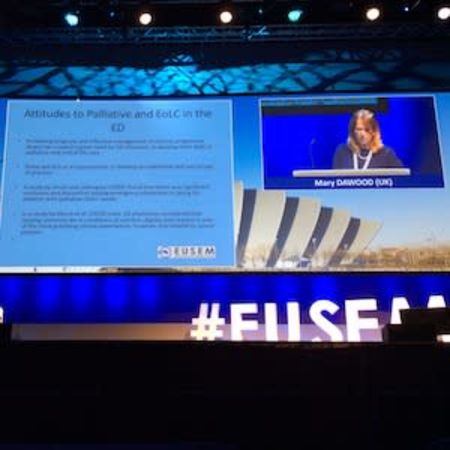Nobody goes into emergency medicine to care for dying patients, but people do die in emergency departments, and end-of-life care could and should be better in the ED, said Mary Dawood, RN, of Imperial College Healthcare NHS Trust, London, speaking at the European Society of Emergency Medicine congress in Glasgow this week.
She noted that EOLC in the ED is under-researched in medicine, with most of the research being in the nursing and social domain. Identified barriers to good EOLC are professional attitudes/understanding, its emotional burden, lack of space, time and staffing resources, dignity and socio/family context. None of these are excuses for poor care, said Dawood. On dignity, she quoted Maya Angelou:
“It means a belief in oneself, that one is worthy of the best. Dignity means that what I have to say is important, and I will say it when it's important for me to say it. Dignity really means that I deserve the best treatment I can receive. And that I have the responsibility to give the best treatment I can to other people.”
The issues include attitudes of staff - the emergency department is “the wrong place to die” . The focus in the ED is on restorative not palliative care. Practically, most EDs were built at a time when patient populations were younger, and hospitals have not caught up with the needs of increasing longevity that arises on a more regular basis.
Challenges also include patient wishes, family anxiety and expectations, cultural expectations, crowding in the ED, paramedic predicament (should they bring in a patient near death?) and the existence of do not attempt resuscitation orders and advanced directives.
Emergency department clinicians need to develop their skills in palliative and end-of-life care. A 2009 study (Smith et al.) found significant confusion and discomfort among emergency physicians in caring for patients with palliative/EOLC needs. A study by Marck et al. (2014) found that most ED physicians considered that helping patients die a ‘good death’, was a gratifying clinical experience, although the study related to cancer patients.
When asking about do not attempt resucitation (DNAR), Dawood advised empathetic communication, as patients and carers can regard it with suspicion and alarm. Relationships that can be built up in days or weeks in palliative care settings need to be formed in hours or even minutes in the ED. Also, it is not always feasible to either make or be aware of existing DNAR orders. Dawood reminded delegates that a doctor breaches article 8 of the European Convention on Human Rights if s/he fails to involve a patient or his family at the time of writing a DNAR.
Talking to patients and families about goals of care is to decide treatment choices and care needed. It should be informed by patient preferences and values and is broader than advanced care planning or DNAR. She recommended a recent article by Arabi and colleagues (2018) Shifting paradigm: From “No Code” and “Do-Not-Resuscitate” to “Goals of Care” policies, published in the Annals of Thoracic Medicine
EDs should be aware of multicultural aspects of death and dying, and have up to date lists of chaplains and spiritual leaders of all denominations.
This scheme uses a swan symbol to represent end of life and bereavement care. The symbols also remind staff to be extra caring and pay extra attention to relatives and friends whose loved ones are at the end of life and in their greatest time of need.
Sign - start the individual care plan if the patient is believed to be entering the dying phase of life
Words - sensitively communicate with the patients and their loved ones
Actions - facilitates what is important to the patient and those coming alongside them
Needs - are the needs of the patient being met, documented and reviewed regularly. The plan is based on the UK National Institute of Health and Care Excellence guidelines for the care of dying adults.
An example of a Swan suite in an ED is at the Shrewsbury and Telford NHS Trust
She noted that EOLC in the ED is under-researched in medicine, with most of the research being in the nursing and social domain. Identified barriers to good EOLC are professional attitudes/understanding, its emotional burden, lack of space, time and staffing resources, dignity and socio/family context. None of these are excuses for poor care, said Dawood. On dignity, she quoted Maya Angelou:
“It means a belief in oneself, that one is worthy of the best. Dignity means that what I have to say is important, and I will say it when it's important for me to say it. Dignity really means that I deserve the best treatment I can receive. And that I have the responsibility to give the best treatment I can to other people.”
The issues include attitudes of staff - the emergency department is “the wrong place to die” . The focus in the ED is on restorative not palliative care. Practically, most EDs were built at a time when patient populations were younger, and hospitals have not caught up with the needs of increasing longevity that arises on a more regular basis.
Challenges also include patient wishes, family anxiety and expectations, cultural expectations, crowding in the ED, paramedic predicament (should they bring in a patient near death?) and the existence of do not attempt resuscitation orders and advanced directives.
Emergency department clinicians need to develop their skills in palliative and end-of-life care. A 2009 study (Smith et al.) found significant confusion and discomfort among emergency physicians in caring for patients with palliative/EOLC needs. A study by Marck et al. (2014) found that most ED physicians considered that helping patients die a ‘good death’, was a gratifying clinical experience, although the study related to cancer patients.
What you need to find out
Questions to ask are if the patient, family or carers know the patient’s prognosis? Ask what their fears are, their goals and what they would like you to do for them.Do not attempt resuscitation orders
When asking about do not attempt resucitation (DNAR), Dawood advised empathetic communication, as patients and carers can regard it with suspicion and alarm. Relationships that can be built up in days or weeks in palliative care settings need to be formed in hours or even minutes in the ED. Also, it is not always feasible to either make or be aware of existing DNAR orders. Dawood reminded delegates that a doctor breaches article 8 of the European Convention on Human Rights if s/he fails to involve a patient or his family at the time of writing a DNAR.
Goals of care
Talking to patients and families about goals of care is to decide treatment choices and care needed. It should be informed by patient preferences and values and is broader than advanced care planning or DNAR. She recommended a recent article by Arabi and colleagues (2018) Shifting paradigm: From “No Code” and “Do-Not-Resuscitate” to “Goals of Care” policies, published in the Annals of Thoracic Medicine
Diversity
EDs should be aware of multicultural aspects of death and dying, and have up to date lists of chaplains and spiritual leaders of all denominations.
Swan project
This scheme uses a swan symbol to represent end of life and bereavement care. The symbols also remind staff to be extra caring and pay extra attention to relatives and friends whose loved ones are at the end of life and in their greatest time of need.
Sign - start the individual care plan if the patient is believed to be entering the dying phase of life
Words - sensitively communicate with the patients and their loved ones
Actions - facilitates what is important to the patient and those coming alongside them
Needs - are the needs of the patient being met, documented and reviewed regularly. The plan is based on the UK National Institute of Health and Care Excellence guidelines for the care of dying adults.
An example of a Swan suite in an ED is at the Shrewsbury and Telford NHS Trust
Key Points
- Accept that provision of EOLC is a necessary purpose of the ED
- Provide a designated space
- Build closer relationships with in-hospital and community palliative care teams
- Provide multidisciplinary training in palliation communication and symptom management
- Focus on goals of care rather than DNRa
- Appoint an EOLC/bereavement lead
- Consider the benefits of focused projects such as the Swan project.
References:
Bailey CJ, Murphy R, Porock D (2011) Dying cases in emergency places: caring for the dying in emergency departments. Soc Sci Med, 73(9): 1371-7
Several guidelines exist on EOLC in the emergency department:
European Recommendations for End-of-Life Care for Adults in Departments of Emergency Medicine (EuSEM 2017)
End of Life Care for Adults in the Emergency Department (RCEM 2015)
Treatment and Care Towards the End of Life: good practice in decision making (GMC, 2010)
Guide on the decision making process regarding medical treatment in end of life situations (Committee on Bioethics of the Council of Europe, 2014)
Several guidelines exist on EOLC in the emergency department:
European Recommendations for End-of-Life Care for Adults in Departments of Emergency Medicine (EuSEM 2017)
End of Life Care for Adults in the Emergency Department (RCEM 2015)
Treatment and Care Towards the End of Life: good practice in decision making (GMC, 2010)
Guide on the decision making process regarding medical treatment in end of life situations (Committee on Bioethics of the Council of Europe, 2014)
Latest Articles
emergency department, end-of-life care, European Society of Emergency Medicine, #EuSEM18, Swan project
Nobody goes into emergency medicine to care for dying patients, but people do die in emergency departments, and end-of-life care could and should be better in the ED, said Mary Dawood, RN, of Imperial College Healthcare NHS Trust, London, speaking at the



























